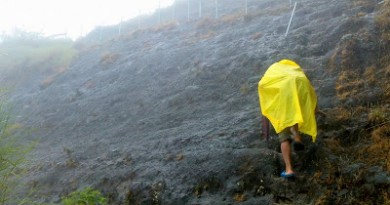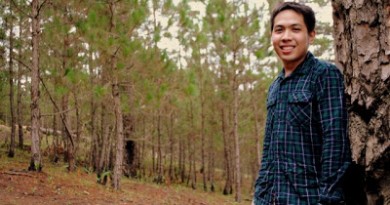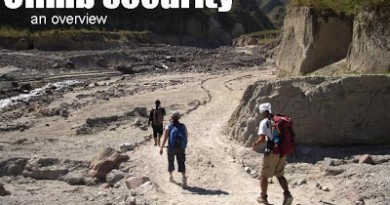camping and climbing checklist – updated 2010
by Gideon Lasco
This annotated checklist, I hope, will help everyone planning a climb. I updated this on 10/12/10 for the benefit of participants for the 2nd Mt. Apo Sembreak Climb next week.
CAMPING + CLOTHING
For overnight climbs, a 40L backpack will do while multi-day trips may require larger packs; make sure to have a raincover with you to protect your pack from rain. Bring tents that would be exact for each group. Don’t forget the pegs that would protect your tent from being collapsed or blown away by wind and the flysheet that will protect your tent from being rained down. A sleeping bag is not a necessity especially when the planned campsite is predictably flat; some tents may have a built-in groundsheet but bringing one is always recommended. An earthpad serves a dual purpose of scaffolding the items in your pack and providing insulation at night.
Sets of clothes: 1 set going up, 1 set in camp, 1 set going down: but actually you can just bring two sets, one going up, and the other at camp you can wear going down; just add a pajama or sweater for the camp itself if it will be cold. For multi-day, rainy climbs, you can have two sets: the wet set during climbing and dry set during camping.
Waterproofing. It is best to make sure everything, especially clothes, are protected from rain. You do not need fancy waterproof packs to achieve this; simply putting your clothes inside plastic bags can serve the purpose. However, items that are waterproof are always cool and useful; look for GORE-TEX fabric in clothes, jackets, and shoes as a mark of waterproofing. Otherwise, make you sure you bring a poncho or raincoat to protect your body in case of rain. Also, choose clothes that easily dry and does not get get heavy with rain. This is the reason why jeans are a no-no!
Cold protection. You can either go for quanity (many layers of clothes) or quality (just a few with the right fabrics and sufficient protection). Not all good fabrics vs. the cold are good against rain, however, such as jackets with goose feathers or those thick ones for winter. So in the setting of cold weather, it is best to have warm insides and a waterproof outside (a Gore-Tex jacket) to keep everything dry. Body warmers such as bonnets, gloves, socks, and thermal underwear are good items. Since tolerance to cold vary from person to person, only experience can definitively tell you how many layers you should bring for a Pulag climb. Three to four is enough on the average, though.
Thin, long-sleeved shirts or rashguards would also serve the purpose of protecting the skin vs. thorns and insects and they are worn with shirts in the same way that leggings are worn with shorts. They have the added benefit of some protection vs. the sun, although wearing sunblock (SPF > 30) is still recommended in exposed trails.
Other items you can bring is a pair of sunglasses/shades to shield your eyes from the intense sunlight at high elevations and a trekking pole (sometimes two) to assist you in steep trails. A trekking pole may not have a purpose at the start, but it could be a precious tool when you get a sprain.
THE CHECKLIST
Backpack / raincover
Tent / groundsheet / earthpad
Sleeping bag*
Hiking shoes / plus optional slippers/sandals
Trekking pants/light pants
Thermal/cotton/wool undershirt
Long sleeved trekking shirt
Sweater
Windbreaker/Jacket
Poncho / raincoat
Extra shirts
Gloves/bonnet/thick socks
Bush hat / cap
Trekking pole*
DRINKING + EATING + COOKING
Water. When bringing water, take the presence and interval of water sources as a guide on how much to bring. In general, 1 liter can last for two hours on mild to moderate sunlight on mild to moderate trails. So if the average interval of water sources for each climb is four hours, it is best to have at least 2-3L water in addition to what you will need in camp for cooking. A cool item is of course the hydration pack (sometimes referred to as a bladder) which can store water inside your pack; you can just sip it from a valve. Water carriers are large, compressible water containers that can act as water dispensers at campsites – and serve as an efficient way to harvest water from sources.
Trail food. It is entirely up to you what kind of trail food you want to bring. Personally, I always bring a mix of dried fruits (dried mangoes, raisins); energy bars (chocolate, oatmeal bars); the traditional gelatin (i.e. JellyAce — but I love those with fruit bits or nata inside); and candies. Don’t forget to keep track of your wrappers! Some climbers prepare their own trail food by filling Ziplocks with ChocNut, bits of Oreo and M&Ms, plus gummy bears, for their personal snack. Don’t buy low-calorie stuff, though – you need the energy!
Meals. It has been mountaineering tradition to cook in camp – i.e. buy meat from the local market, rice, etcetera. However, don’t feel embarrassed if you will resort to canned goods. The important thing is leaving nothing at the campsite, especially those tin cans. Cooking rice up in the mountains is just like doing it in town, but water boils faster in high altitudes so make adjustments. Pasta – or sotanghon – is advocated by some as an easier alternative to rice. Oil of course is very important and personally I always want something to spice things up like peppers or chili powder.
Stove. A majority of portable stoves in the Philippines are still butane-based although there is an emerging number of multi-fuel ones. Make sure you have enough fuel for the climb; one butane cylinder usually lasts for 1-2 meals. I usually bring 1 cylinder for each night, plus an extra. As for the stove, of course you have to bring one. Setting up a fire for cooking in campsites is not a recommended practice. Bring a ligher or matches just in case the igniter of your stove conks out.
Cooking and eating utensils. Your cooking utensils can double as your eating utensils. The higher-end ones are made of titanium although the classic Kovea cooker set is a very good deal. Bring spoons/forks/knives; they can all be combined in a camping Swiss knife so learn how to economize on space and items.
After meals. If water is limited, the utensils may be cleaned by a wet tissue/towel with alcohol. Don’t leave utensils with food lest you attract mountain rats and other guests. If there is a water source, do your cleaning downstream so as not to contaminate the source.
THE CHECKLIST
2-3L water or liquids / hydration pack or water carriers
Rice / precooked/uncooked meat
Noodles / instant coffee
Oil / garlic / pepper
Portable stove and fuel
COoking/eating utensils
Spoon/fork/knife/can opener
Lighter /matches
Garbage bags/Ziplocks
TOILETRIES
Needless to say, you have to mind your personal needs even when in the mountains. First on the checklist is a trowel (though one per group will do) which you will use to dig a hole for your waste; the rest are quite self-explanatory. You may not need these during the climb itself, but at the jumpoff, a postclimb shower may be a good reward — and something you need to sleep all the more soundly on the bus back home.
THE CHECKLIST
Trowel /tissue paper
Soap/ Shampoo
Toothbrush / toothpaste
Alcohol
Mirror
GADGETRY
This is like a PC game in real life – you can actually use cool gadgets in real life as you climb. Of course, the most basic ones are a flashlight or headlamp (go for long battery life) and a camera. Virtually everybody has a digital camera by now and of course outdoor photography is best served by a dSLR. Navigation and expedition people, on the other hand, bring GPS / altimeter watches: these are vital on explorations. Otherwise, a compass is basic. In all these, don’t forget to bring extra batteries because cold temperatures drain batteries. And, if it rains, make sure you have a waterproof solution.
THE CHECKLIST
Flashlight / headlamps
Camera / binoculars
Cellphone / Two-way radios
GPS / altimeter watches
Compass / Topographic maps
Extra batteries / memory
PROTECTION + EMERGENCY + UTILITIES
I always bring a notebook with me and a pen to document the climb; but it can also be handy in emergencies. You can use ribbons to mark your path on an uncharted trail, and a whistle will spare you from the need to shout at the top of your voice. A utility rope is advised for mountains with steep trails (to assist hikers), for river crossings, and the lake. but a first aid kit is very important. If you have an existing condition like asthma, never ever forget your personal medications! And when somebody finds you unconscious, make sure a contact number (and blood type) can be found somewhere.
CHECKLIST
Ballpen / paper/ ribbons / whistle
Lighter /matches
Insect repellant / Sunscreen or sunblock (>SPF 30)
First aid kit / Personal medications (see separate article)
Utility rope*





Leave a Reply
29 Comments on "camping and climbing checklist – updated 2010"
Thanks.. this helps…
thanks for this list. ako yung sa lighter part gamit ko lagi is zippo lighter wind proof very convenient to use
sir… im aware that alot of climbers/hikers are very poor in menu planning… im one of them.
could you please set up as well menu plans here..
lalo sa mga multi day hikes
thanks!
team N+J
Hi, your blog site really helped me through my 1st hiking experience. Thank you!:) I put up a draft of my quick list meant specifically for women hikers and was wondering if you can help me comb through it as all I offered was amateur advice.
My site: http://www.justplunge.wordpress.com. Thanks!
sorry, kulang yung na-type ko sa post ko above.
Paragraph 2, the baby oil will act as another layer that will help lower down body heat "LOSS"
thank you… 🙂